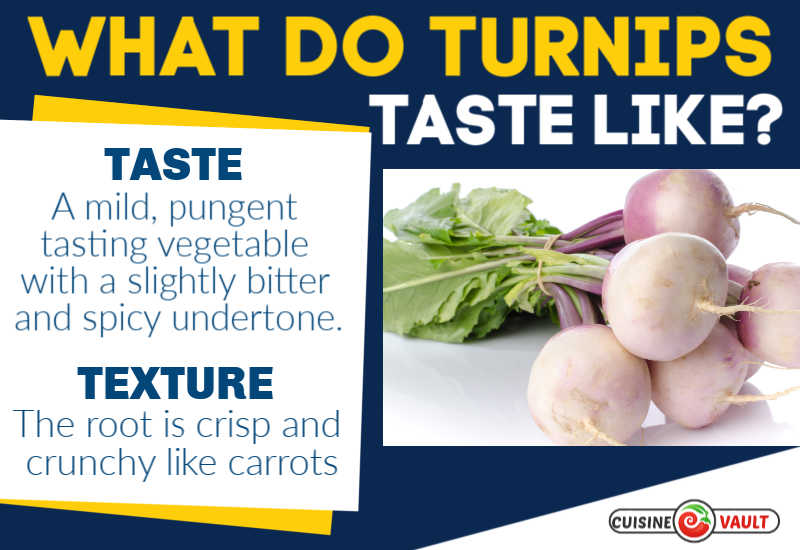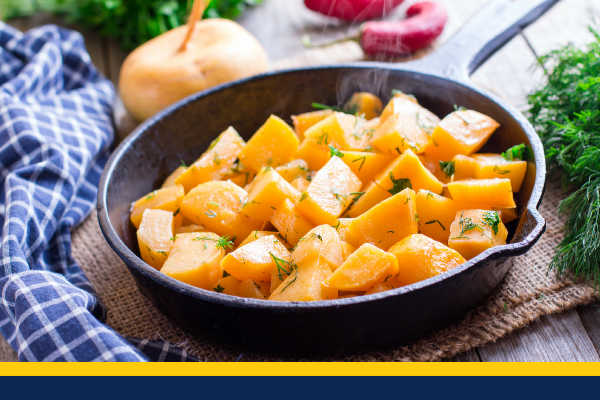When it comes to vegetables, turnips won’t win any awards for the sexiest food on offer. In recent decades people have considered them old-fashioned in many Western countries.
 But, is this perception justified, or are we judging a perfectly good root vegetable too harshly? The Nords practically worship this nutritious crop and frequently replace potatoes with them. In this article, we’ll answer the question, “what do turnips taste like” so that you know if they’re worth eating.
But, is this perception justified, or are we judging a perfectly good root vegetable too harshly? The Nords practically worship this nutritious crop and frequently replace potatoes with them. In this article, we’ll answer the question, “what do turnips taste like” so that you know if they’re worth eating.
Table of Contents
Reviewing the turnip's taste
Turnips are a mild, pungent tasting vegetable with a slightly bitter and spicy undertone. They taste a cross between a cabbage and a radish. Their texture is crisp and crunchy like carrots.
 Age can affect the flavor of a turnip with the younger version being sweeter. As they mature, the texture becomes woodier, and a bitter taste intensifies, although cooking can reduce this.
Age can affect the flavor of a turnip with the younger version being sweeter. As they mature, the texture becomes woodier, and a bitter taste intensifies, although cooking can reduce this.
Turnip greens comprise of the stem and leaves and have a similar flavor profile to the root. When picked fresh and tender, they are excellent cooked in Asian stirfrys.
What flavors go with turnip
The slightly bitter taste of turnip is balanced out by spicy, flavor-packed spices and meat that’s high in fat content.
| Seasoning | Vegetables | Protein |
|---|---|---|
| Rosemary | Carrot | Beef |
| Thyme | Parsnip | Bacon |
| Garlic | Sweet Potato | Turkey |
| Cilantro | Potato | Veal |
| Ginger | Rutabaga | Chicken |
| Paprika | Onion | Lamb |
| Sage | Zucchini | Mutton |
What are Turnips?
Turnips are a root vegetable from the same family as rapini, cauliflower, and cabbage. They are a hardy biennial crop that proliferates in cool climates. Turnips look a lot like rutabaga but, although they are cousins, they are not the same vegetable.
Nutritional Information
Turnips are considered a very healthy ingredient, packed with nutrients and low in calories. They make an excellent substitute for potatoes for those looking to reduce their carbohydrate intake. One cup of raw turnip provides just 6 grams of carbs; for the same quantity of potato, you’ll get 22 grams.
Other useful benefits of the turnip include high levels of Vitamin A, C, K, folate, fiber, and calcium. The healthiest way to eat them is raw. Young, uncooked turnips, once peeled, are delicious cut into sticks and served with hummus.
Fun Facts
- Turnips used to be carved during Halloween instead of pumpkins, in the United Kingdom.
- Turnips love cold weather in Winter, and they taste sweeter harvested after a frost.
- Turnips have zero waste as the entire plant can be eaten.
- A large variety of turnip is cultivated to feed livestock.
How to choose a turnip in the store
Usually, when people complain about lousy tasting turnips, it is because they chose an old one. It will have developed too much pungent flavor and a fibrous texture. The secret is selecting young produce that is milder in taste.

Choose small turnips that are heavy for their size.
Old turnips will have a slight pink tinge and will look larger than the others. Instead, look for the smallest one you can find on the shelf. Anything bigger than 3” in diameter is too big. Feel the weight of each turnip and choose one that seems heavy for its small size. Its skin should be purple, yellow, or white and feel smooth with a faintly sweet aroma. Avoid turnips with blemishes or cracks.
Do You Have to Peel Turnips?
It isn’t essential to peel turnips, and the skin is edible. But, unless you have the most tender, new-season bulb, the skin will be thick and unpleasant tasting. To peel a turnip, use a peeler or a paring knife as you would a potato.
You might also like:
What are the best rutabaga substitutes?
What does kangaroo meat taste like?
What does brain taste like?
Storage advice
If you managed to buy turnips with their leaves still intact, then you should cut them off once you’re in the kitchen.
Wrap the bulbs in a moist paper towel or cloth and then place them in a plastic bag in your refrigerator’s vegetable crisper. They will keep for around 4-5 months when refrigerated.
Store the unwashed turnip greens in a sealed plastic bag in the fridge. They will stay good for up to five days. They are also suitable for freezing: wash thoroughly then blanch in boiling water for 2-3 minutes. Finally, chill the leaves in ice water, dry with a towel, and store in an airtight container or zip-lock bag in the freezer. Turnip greens can be frozen for up to 12 months.
Recommended cooking methods
Mashed
Mashing turnips is one of the more popular uses for this vegetable. It’s quick and easy. We recommend making a tasty mash dish that is a blend of half turnip and half potato (or sweet potato). To do this, roughly chop equal quantities of potato and turnip and boil in a saucepan until soft. Mash with a thick knob of butter, salt, pepper, and a splash of milk until smooth. If the mixture is a little dry, continue adding more milk until the consistency is how you like it.
Roasted
Roasted turnip is almost as good as sunchoke. This recipe is even easier than mashing them. To roast, chop the turnip root into cubes, slather with olive oil and season. Layer evenly on an oven tray and toss in some sprigs of rosemary and garlic cloves, and add a drizzle of honey. Roast the vegetables at 3550F for 45 minutes or until tender on the inside and golden on the outside.

Roast turnips in a skillet until golden.
Turnip Dip
You’ve probably heard of spinach dip, right? Well, turnip leaves will also work deliciously as a dip. The turnips must be a tender, new-season crop. Recipes for making this dip is child’s play: steam the well-cleaned leaves until they are wilted then strain to remove any water. Process the leaves in a blender with a clove of garlic, salt, pepper, and half a cup of cream cheese. Some roasted cashews will further enhance the flavor of your dip.
Casseroles
Turnips combine with gravy beef, potato, pumpkin, parsnip, onion, and carrot to make a heart-warming winter casserole. To dial up the flavor, include garlic, bay leaves, and rosemary. Toss all these ingredients into a slow cooker with some beef stock and slow cook for 4 hours for a delicious meal.

Turnips are an excellent winter stew vegetable.
Turnip fries
Potato fries are great, but if you feel like a change, try turnip fries. Boil the roots in water until they are just turning soft then remove from the heat. Allow to cool a little before chopping into thin sticks and frying in vegetable oil until golden and crispy. Serve with ketchup and mayo when you’re short on time – a healthy snack the whole family will love,
Stirfry
If you’re partial to Asian stirfries then add a new depth of flavor with turnip greens. You can toss in the leaves and stems as they will soften once cooked. Be sure to use young, tender turnips that have a mild sweetness without too much spicy pungency.

The leafy part of turnips can also be eaten.
Reducing the bitterness
A common issue that people have with turnips is the bitter flavor that the larger plants have. We can offer two options to overcome this unpleasant taste:
1. For the leaves: blanch them first, then fry in olive oil. The first step helps remove the bitter taste.
2. For the root: peel and chop the turnip, then cover with olive oil and seasoning. Scoop the pieces into an airtight container and refrigerate for an hour. Now you can cook using your preferred method; only the bitterness will be less.
Recommended reading:
What do artichokes taste like?
What does butternut squash taste like?
What does lotus root taste like?
Summing up
Are you wondering what turnips taste like? You’ll find that they are a mild, pungent tasting vegetable with a bitter and spicy undertone. The root’s texture is crisp and crunchy like carrots. If you happen to eat a large, mature turnip, it will have increased spiciness with a woodier texture.
Turnips won't be to everyone's taste due to their pungent flavor. Do you have a bunch of them in the kitchen and have fussy eaters? Your best bet is to mash them with another more common vegetable like potato, sweet potato or even carrot.
Have you tried turnip before? Let us know in the comments below if you enjoyed them.

Leave a Reply